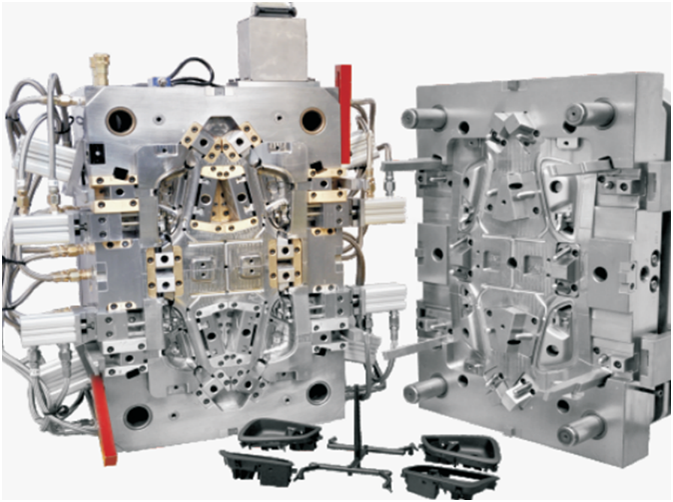
date:2023/08/10
It has good matching of mechanical properties such as tensile strength, yield strength, section shrinkage, elongation, impact toughness and hardness in the range of service temperature (room temperature to maximum working temperature).
Precision plastic mold
1) Tensile strength and yield strength
Different types of molds have particular emphasis on the mechanical properties required by forging die materials. At the same time, the mechanical properties of room temperature should not be considered only while the performance of actual working temperature should be ignored. Avoid pursuing high overall targets that are blind to reality. For example, when the deformation resistance of the hard alloy forging is extremely high in cold forging, when the stress borne by the die exceeds the tensile strength of the forging material at the service temperature, the die will crack and be scrapped. If the stress of the die exceeds the yield strength of the forging material at the service temperature, it will cause the die collapse and other permanent deformation, resulting in the forging out of tolerance. Under this condition, it is necessary to choose the forging die material with high tensile strength and yield strength. In general, the tensile strength of forging die material should be more than 30% of the stress.
2) Impact toughness, section shrinkage and elongation
Because the selection of the impact toughness index of forging die materials is closely related to the forging load property, for the forging dies used in the impact load equipment such as hammer and screw press, if the impact toughness of forging die materials is low, the die may crack and be scrapped. Under such conditions, the forging die material with high impact toughness should be selected.
For forging die materials with high section shrinkage and elongation, they can continue to be used in the case of small cracks, rather than rupture soon. Therefore, under the conditions of tensile strength, yield strength and hardness indicators permit, as far as possible to improve their section shrinkage and elongation.

3) hardness
In view of the corresponding relationship between hardness and strength index, but also closely related to the mold wear resistance, in the impact toughness, section shrinkage and elongation and other indicators permit conditions, as far as possible to improve its hardness (or wear resistance). The hardness and red hardness of forging die are important properties of forging die materials. The shape and size of the die should not change when working at high temperature.
As is known to all, the tensile strength, yield strength, hardness and section shrinkage, elongation, impact toughness of the same forging die material have a contradictory relationship. If the former is improved, the latter must be sacrificed, which needs to choose the corresponding performance matching according to the actual working environment of the specific die.
It must be pointed out that the hardness of the material in a certain degree not only can reflect the strength level, and hardness and wear resistance have sweet corresponding relationship, general hardness of high material, its wear resistance is good, therefore, many forging die materials usually only simply specify the requirements of hardness.
2. Fatigue performance
The fatigue properties of forging die materials include mechanical fatigue and cold and hot fatigue. The hot die alternates between high mechanical load and zero mechanical load for a long time and the temperature range of 200℃ ~ 600℃. The stress caused by the loading and unloading of these two kinds of pulses is superimposed. Over time, microcracks will appear on the surface of the mold bore. The further development of microcracks will accelerate mold wear and produce fragments, resulting in mold failure, so it is required that the forging mold material should have good resistance to mechanical fatigue and cold and hot fatigue.
3. Organizational stability
Usually, hot-work die working temperature at 200 ℃ ~ 600 ℃ or higher, in such a wide temperature range and impulse type under the action of heat load and mechanical load for a long time, will cause the forging die materials organization change and performance instability, such as hardness, lead to accelerated wear, plastic deformation and cracks, so that the mold failure early. Therefore, the stability of forging die material is of great significance to the service life of forging die. Good thermal conductivity and fire resistance of forging die materials can keep the hardness and microstructure stability of die surface under complicated working conditions.
A simple method commonly used to check the structural stability of forging die material is to hold the material for a long time at the working temperature of the die (a predetermined life period is usually chosen), and then measure the corresponding hardness at different temperatures and for different times. The hardness value can qualitatively reflect the tensile strength and anti-wear level of the material.
4. Cold and hot processing performance
Die material is in high hardness, high strength, high wear resistance and toughness enough use, under the condition of the hot and cold processing is very difficult, therefore, request to die forging die materials should have important influences on the comprehensive technical and economic index of smelting, casting, forging, machining, heat treatment and surface treatment and hot and cold processing performance.
5. Metallurgical quality
The metallurgical quality of forging die material has a very important influence on the reliability, life and economy of the die. Any part of a mold mechanical properties and low power and high power must be accord with the requirement of technical conditions, there is no visual visible of nonmetallic and metallic inclusions, shrinkage, uneven grain, serious segregation and loose, white spots, crack, naphthalene macrostructure defects such as fracture, and burnt, overheating, severe high tissue defects such as decarburization, carburizing.
After the composition of die steel is determined (according to the national or enterprise standards), the main factors that determine the quality of die steel module are metallurgical process and subsequent processing process. The production practice has proved that the steel smelted by electroslag furnace is better, with high purity, compact, uniform and small anisotropy, and the modules made by electroslag ingots through hot deformation forging, repeated upsetting and corresponding heat treatment are more suitable for manufacturing forging dies.
6. Hardenability
The higher the hardenability of the die steel, the deeper the hardening layer (the surface martensite structure to the depth of the semi-martensite structure), the better the wear resistance of the die. Hardenability is an important mark to measure the quenching ability of die steel and an important basis to select die steel and its heat treatment process.
Physical properties
The material of forging die requires good thermal conductivity to ensure the heat conduction loss on the surface of the die cavity as soon as possible, to avoid the loss of the mechanical properties of the die due to the high working surface temperature. Keep the hardness of the mold, which is helpful to reduce the thermal wear and fatigue damage.